zxing二维码生车深度定制
二维码生成服务之深度定制
之前写了一篇二维码服务定制的博文,现在则在之前的基础上,再进一步,花样的实现深度定制的需求,我们的目标是二维码上的一切都是可以由用户来随意指定
设计
1. 技术相关
- zxing 开源包用于生成二维码
- springboot 搭建基本web服务,提供http接口
- awt 用于图片的编辑
- httpclient 用于从网络下载图片
- lombok 简化编码
2. 目的
既然是对二维码服务的深度定制,那我们的目的基本上就是二维码上面出现的东西,都可以按照我们的需求进行改造
这里,我们设计两个目的,一个基础版,一个进阶版
-
基础版
- 二维码大小
- 边距留白指定
- 添加logo
- 加背景
-
进阶版
- 二维码中前置色和背景色可自由指定颜色
- 二维码中前置色(黑白二维码中的黑色区域)可换成圆点,三角形等其他图形
- 前置色可用图片替换
- 探测点(三个矩形框就是探测点,也叫做定位点)颜色可配置
- 探测点可用图片替换
- 二维码样式(圆角矩形,添加边框,边框颜色可指定)
- 背景支持填充(填充在背景图片的某个区域)和覆盖方式(全覆盖背景图,二维码设置透明度)
上面是我们希望达到的目的,下面给几个实际生成的二维码瞅瞅最终的效果
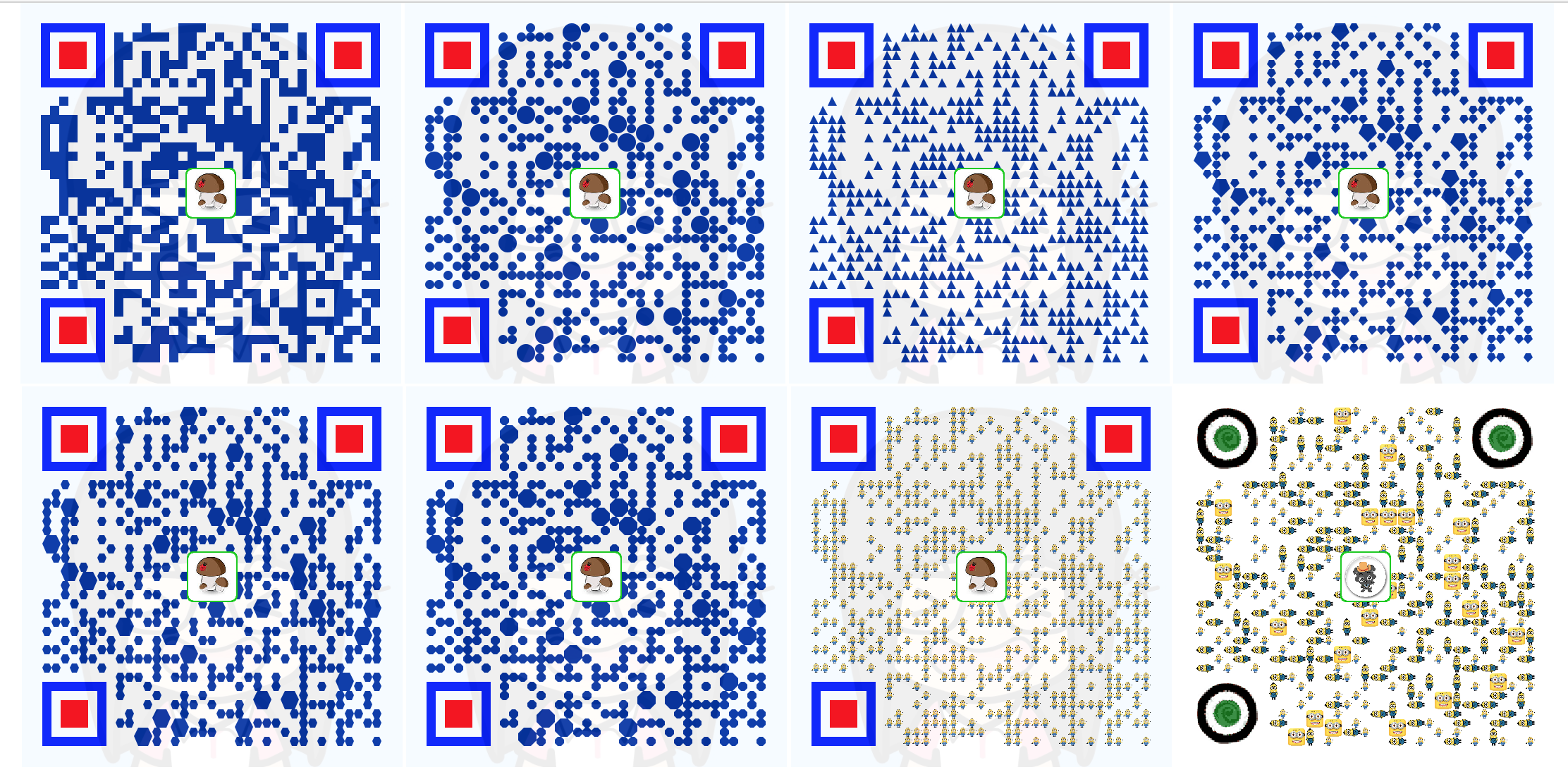 输入图片说明
输入图片说明
<font color="red">(小灰灰blog公众号,实际测试时,请用微信扫一扫)</font>
3. 前提准备
1.相关博文
在直接进入上面花样的二维码生成之前,有必要安利一把zxing的基本使用方式,本篇将不会对如何使用zxing进行说明,有需求了解的可以参考下面几篇相关博文,此篇博文是 《spring-boot & zxing 搭建二维码服务》 的衍生
2. 源码介绍
此外下面直接贴代码,可能有些地方不太容易理解,下面将简单对一些辅助类进行必要的功能说明
源码直通车:quick-media
涉及到的工具类:
-
QrCodeUtil: 二维码生成工具类- 生成二维码矩阵
- 根据二维码矩阵渲染二维码图片
-
ImageUtil: 图片处理工具类- 加载图片(支持从本地,网络获取图片)
- 绘制二维码logo
- 图片圆角化
- 图片添加纯色边框
- 背景绘制
- 二维码绘制
-
QrCodeOptions: 二维码配置类 -
BitMatrixEx: 二维码矩阵信息扩展类 -
QrCodeGenWrapper: 二维码生成服务包装类,与用户进行交互的主要接口,设置配置信息,生成二维码,选择输出方式,都是通过它来设定
4. 实现说明
第一步,生成矩阵
我们直接利用zxing来生成二维码矩阵信息,并用来实例我们的矩阵拓展类 BitMatrixEx
在我们的工程中,相关的代码为
com.hust.hui.quickmedia.common.util.QrCodeUtil#encode
在这里,只关心下面几个参数的生成,其他的基本上就是zxing库的调用了
/**
* 实际生成二维码的宽
*/
private int width;
/**
* 实际生成二维码的高
*/
private int height;
/**
* 左白边大小
*/
private int leftPadding;
/**
* 上白边大小
*/
private int topPadding;
/**
* 矩阵信息缩放比例
*/
private int multiple;
private ByteMatrix byteMatrix;
在理解为什么有上面的几个参数之前,有必要看一下byteMatrix到底是个什么东西?(自问自答:二维码矩阵)
下面截出前面二维码中对应的矩阵信息,在生成一张二维码时,下面的1表示一个小黑块,0表示一个小白块;
1 1 1 1 1 1 1 0 0 0 0 1 0 0 0 1 1 1 0 0 0 0 0 1 0 1 1 0 0 0 1 1 1 1 1 1 1
1 0 0 0 0 0 1 0 1 0 1 1 1 1 0 1 1 0 0 1 0 0 1 0 1 0 0 0 1 0 1 0 0 0 0 0 1
1 0 1 1 1 0 1 0 1 1 0 0 0 0 0 1 1 0 1 0 1 0 1 0 0 1 0 0 1 0 1 0 1 1 1 0 1
1 0 1 1 1 0 1 0 1 1 0 1 0 1 0 1 0 1 0 0 0 1 0 1 0 0 1 0 1 0 1 0 1 1 1 0 1
1 0 1 1 1 0 1 0 1 0 0 1 0 1 1 1 0 0 0 0 1 1 0 0 1 1 0 0 0 0 1 0 1 1 1 0 1
1 0 0 0 0 0 1 0 1 0 0 1 0 1 0 0 0 1 1 0 1 1 1 0 0 1 0 0 1 0 1 0 0 0 0 0 1
1 1 1 1 1 1 1 0 1 0 1 0 1 0 1 0 1 0 1 0 1 0 1 0 1 0 1 0 1 0 1 1 1 1 1 1 1
0 0 0 0 0 0 0 0 0 1 0 0 0 0 0 0 0 0 1 0 0 1 0 0 1 0 1 1 1 0 0 0 0 0 0 0 0
0 0 1 0 0 1 1 1 1 1 0 1 1 0 0 1 1 1 1 0 1 1 0 0 1 0 0 0 0 1 0 1 1 1 1 1 0
0 1 0 0 0 1 0 1 0 1 1 1 0 1 1 0 1 1 0 0 1 0 1 0 1 0 0 1 0 0 1 1 0 1 0 0 1
1 1 1 1 0 0 1 0 1 0 1 1 1 0 0 1 1 1 1 0 1 1 1 0 1 0 0 1 0 1 1 0 1 0 0 1 1
1 0 1 1 0 0 0 0 0 1 0 0 0 1 0 1 0 0 1 1 1 1 1 1 1 0 1 0 0 0 0 1 0 0 0 0 1
1 0 1 1 0 0 1 0 1 0 1 1 1 0 0 0 0 0 1 1 1 1 1 1 1 0 0 0 1 1 1 0 0 0 0 1 1
1 0 1 0 0 0 0 0 0 1 1 0 0 1 1 1 1 0 0 1 0 1 1 1 0 1 0 0 1 1 1 0 0 0 1 0 1
1 1 1 1 0 0 1 0 0 0 0 0 1 1 1 0 1 1 1 0 0 0 1 1 1 0 0 1 0 1 1 0 0 1 1 0 1
1 1 1 0 0 0 0 1 0 1 0 1 1 1 1 1 1 0 0 0 1 0 1 0 1 0 1 0 0 1 0 0 0 1 0 0 0
0 1 1 0 0 0 1 0 0 1 0 1 0 0 1 0 0 0 0 0 0 0 1 0 1 0 0 1 1 0 1 0 0 0 0 1 0
0 0 1 1 1 0 0 0 0 1 0 1 1 1 0 0 1 0 1 1 1 0 0 0 1 0 0 1 1 1 1 1 0 0 1 0 1
0 0 1 1 1 1 1 1 0 0 1 0 1 0 0 1 0 0 0 1 1 1 1 1 0 1 1 1 1 1 0 1 0 0 1 0 1
0 0 1 0 1 1 0 1 1 0 1 0 0 0 0 0 1 0 0 0 1 1 1 0 1 0 0 1 1 1 0 1 1 1 0 1 1
0 0 1 0 1 0 1 0 0 1 0 1 1 0 0 1 1 0 0 0 1 1 1 0 0 1 0 0 1 0 1 0 0 1 0 1 0
1 1 0 1 0 0 0 0 1 0 0 0 0 1 1 0 0 1 1 1 0 0 0 1 1 1 0 1 0 1 1 1 0 1 1 1 1
1 0 0 0 1 0 1 1 0 1 1 0 1 1 0 0 0 0 1 1 0 0 1 1 1 0 0 1 0 1 1 1 1 0 0 1 1
0 1 1 0 1 1 0 0 1 1 0 1 1 0 1 0 1 0 1 1 1 1 0 0 0 0 1 1 1 1 1 1 0 1 0 1 0
1 0 0 1 0 1 1 0 1 1 0 0 0 1 1 0 1 0 0 0 0 0 1 0 1 1 0 0 0 0 1 0 1 1 1 1 1
0 0 1 0 1 1 0 1 0 0 1 0 1 1 1 0 0 1 1 0 0 0 0 0 1 0 0 1 0 0 0 1 0 0 1 1 1
1 1 0 1 1 0 1 1 0 1 0 0 1 0 0 1 1 0 0 0 0 1 1 0 1 1 0 1 1 1 0 1 0 1 1 0 1
0 0 1 0 1 1 0 0 1 1 1 1 1 1 1 1 1 1 0 0 0 1 0 1 1 0 1 0 1 0 1 0 0 1 0 1 1
1 1 0 1 0 0 1 0 0 0 0 0 1 0 0 1 0 0 1 0 1 1 0 0 0 0 0 0 1 1 1 1 1 0 0 0 0
0 0 0 0 0 0 0 0 1 1 1 0 1 0 1 1 1 0 1 1 1 0 1 1 0 1 0 0 1 0 0 0 1 1 0 1 1
1 1 1 1 1 1 1 0 1 0 0 1 0 0 0 0 0 0 1 0 0 1 0 1 0 1 0 0 1 0 1 0 1 1 1 0 1
1 0 0 0 0 0 1 0 1 0 0 0 1 0 0 1 0 1 0 0 0 0 0 1 1 0 1 1 1 0 0 0 1 1 0 1 0
1 0 1 1 1 0 1 0 0 0 0 1 0 0 1 1 1 0 1 0 0 1 0 1 1 0 1 1 1 1 1 1 1 0 0 1 0
1 0 1 1 1 0 1 0 0 1 0 0 1 1 0 1 0 0 0 1 1 1 0 0 0 0 0 1 1 0 0 1 0 1 1 0 1
1 0 1 1 1 0 1 0 1 1 0 0 1 1 1 1 0 1 0 0 0 1 1 1 1 1 0 0 1 1 0 0 1 1 0 1 1
1 0 0 0 0 0 1 0 0 0 1 1 1 0 1 1 1 1 1 0 0 1 1 0 0 0 1 0 1 0 0 0 1 0 0 0 0
1 1 1 1 1 1 1 0 0 0 1 1 1 0 1 0 0 0 0 0 0 1 1 0 1 0 0 1 1 0 1 0 1 1 0 0 1
当生成了上面的人矩阵之后,最终的二维码绘制都是根据上面的矩阵来的,将1的地方用我们希望绘制的样式(如圆点,三角形,图形等)来替换;
上面的矩阵表示的基本的二维码信息,最终渲染二维码图片时,我们还需要知道最终的图片大小,四周的留白空间,每个二维码信息在放射到最终二维码图片时放大的倍数,有这些参数之后才能唯一指定最终的输出结果,所以就有了上面的几个参数
第二步, 二维码信息的绘制
根据上面的二维码矩阵来渲染二维码图片,先考虑最简单的,没有任何配置时,可以怎么玩?
下面用到的参数来自BitMatirxEx
- 绘制整个背景(直接根据给定的宽高绘制矩形背景即可)
g2.setColor(Color.WHITE);
g2.fillRect(0, 0, qrCodeWidth, qrCodeHeight);
- 二维码矩阵中(x,y) == 1的地方绘制小方块
g2.setColor(Color.BLACK);
g2.fillRect(x+leftPadding, y+topPadding, multiple, multiple);
- 根据2可知,整个渲染就是矩阵(二维数组)的遍历而已
根据上面的生成逻辑,我们可以很清晰的发现,有几个目标是可以很简单实现的
- 二维码背景色&前置色的指定(就是在1,2步骤中的setColor用指定的颜色替换即可)
- 替换二维码黑色小方块为其他图形
这里是一个小关键点了,在具体的实现中,我提供了:
- 三角形,
- 矩形(即二维码默认格式),
- 五边形(钻石),
- 六边形,
- 八边形,
- 圆形,
- 图片
<font color="red">比较遗憾的是五角星没有支持,没想到合适的绘制方式</font>
不同的样式,对应的绘制不同,我们定义了一个枚举,来定义不同的样式对应的绘制规则,优势就是扩展自定义样式方便,下面给出具体的绘制代码
/**
* 绘制二维码信息的样式
*/
public enum DrawStyle {
RECT { // 矩形
@Override
public void draw(Graphics2D g2d, int x, int y, int w, int h, BufferedImage img) {
g2d.fillRect(x, y, w, h);
}
@Override
public boolean expand(ExpandType expandType) {
return true;
}
},
CIRCLE {
// 圆点
@Override
public void draw(Graphics2D g2d, int x, int y, int w, int h, BufferedImage img) {
g2d.fill(new Ellipse2D.Float(x, y, w, h));
}
@Override
public boolean expand(ExpandType expandType) {
return expandType == ExpandType.SIZE4;
}
},
TRIANGLE {
// 三角形
@Override
public void draw(Graphics2D g2d, int x, int y, int w, int h, BufferedImage img) {
int px[] = {x, x + (w >> 1), x + w};
int py[] = {y + w, y, y + w};
g2d.fillPolygon(px, py, 3);
}
@Override
public boolean expand(ExpandType expandType) {
return false;
}
},
DIAMOND {
// 五边形-钻石
@Override
public void draw(Graphics2D g2d, int x, int y, int size, int h, BufferedImage img) {
int cell4 = size >> 2;
int cell2 = size >> 1;
int px[] = {x + cell4, x + size - cell4, x + size, x + cell2, x};
int py[] = {y, y, y + cell2, y + size, y + cell2};
g2d.fillPolygon(px, py, 5);
}
@Override
public boolean expand(ExpandType expandType) {
return expandType == ExpandType.SIZE4;
}
},
SEXANGLE {
// 六边形
@Override
public void draw(Graphics2D g2d, int x, int y, int size, int h, BufferedImage img) {
int add = size >> 2;
int px[] = {x + add, x + size - add, x + size, x + size - add, x + add, x};
int py[] = {y, y, y + add + add, y + size, y + size, y + add + add};
g2d.fillPolygon(px, py, 6);
}
@Override
public boolean expand(ExpandType expandType) {
return expandType == ExpandType.SIZE4;
}
},
OCTAGON {
// 八边形
@Override
public void draw(Graphics2D g2d, int x, int y, int size, int h, BufferedImage img) {
int add = size / 3;
int px[] = {x + add, x + size - add, x + size, x + size, x + size - add, x + add, x, x};
int py[] = {y, y, y + add, y + size - add, y + size, y + size, y + size - add, y + add};
g2d.fillPolygon(px, py, 8);
}
@Override
public boolean expand(ExpandType expandType) {
return expandType == ExpandType.SIZE4;
}
},
IMAGE {
// 自定义图片
@Override
public void draw(Graphics2D g2d, int x, int y, int w, int h, BufferedImage img) {
g2d.drawImage(img, x, y, w, h, null);
}
@Override
public boolean expand(ExpandType expandType) {
return true;
}
},;
private static Map<String, DrawStyle> map;
static {
map = new HashMap<>(7);
for (DrawStyle style : DrawStyle.values()) {
map.put(style.name(), style);
}
}
public static DrawStyle getDrawStyle(String name) {
if (StringUtils.isBlank(name)) { // 默认返回矩形
return RECT;
}
DrawStyle style = map.get(name.toUpperCase());
return style == null ? RECT : style;
}
public abstract void draw(Graphics2D g2d, int x, int y, int w, int h, BufferedImage img);
/**
* 返回是否支持绘制图形的扩展
*
* @param expandType
* @return
*/
public abstract boolean expand(ExpandType expandType);
}
上面完成了二维码样式的定制,还有一个探测点(或者叫做定位点)的定制,也得在这一步中进行;
普通的二维码结构如下
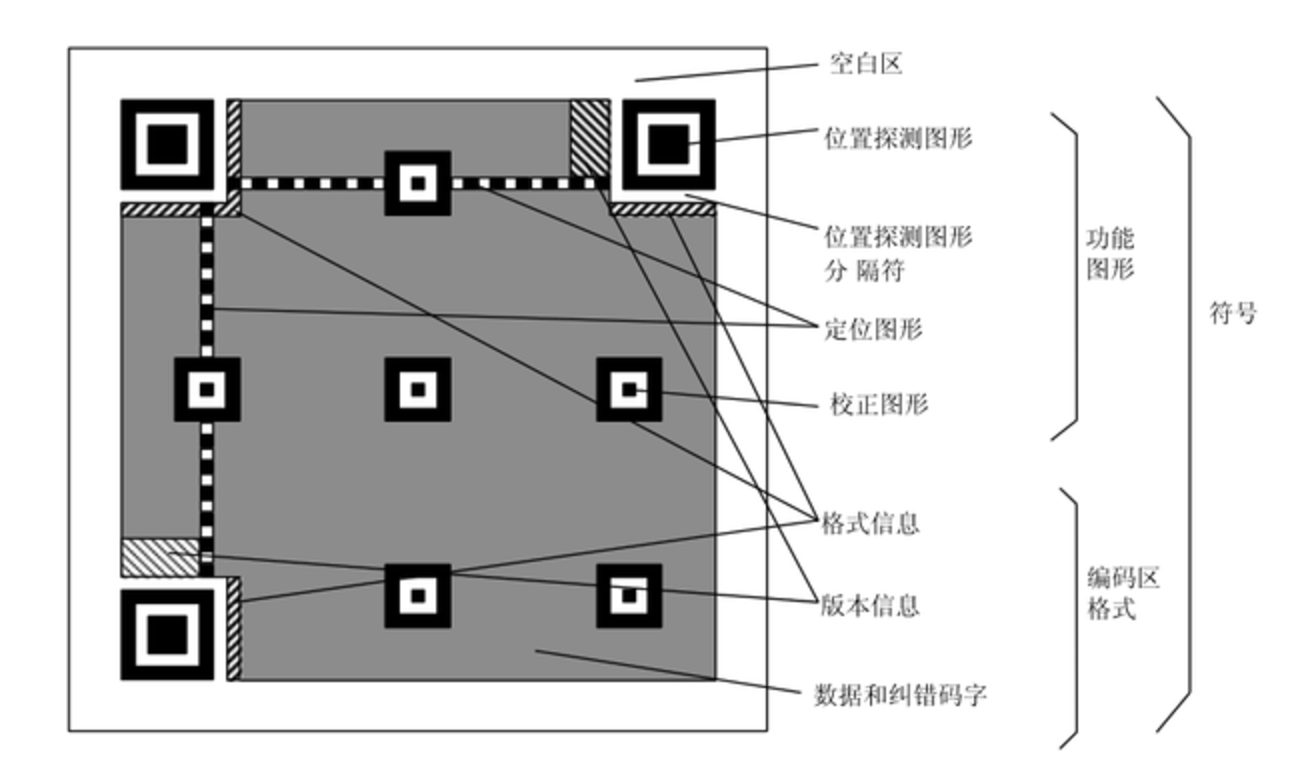 二维码结构
二维码结构
探测点就是二维码中的三个方块,再看上面的二维码矩阵,下图中的两个红框内的其实就是上面的两个探测图形,外面的那层全0是分割符
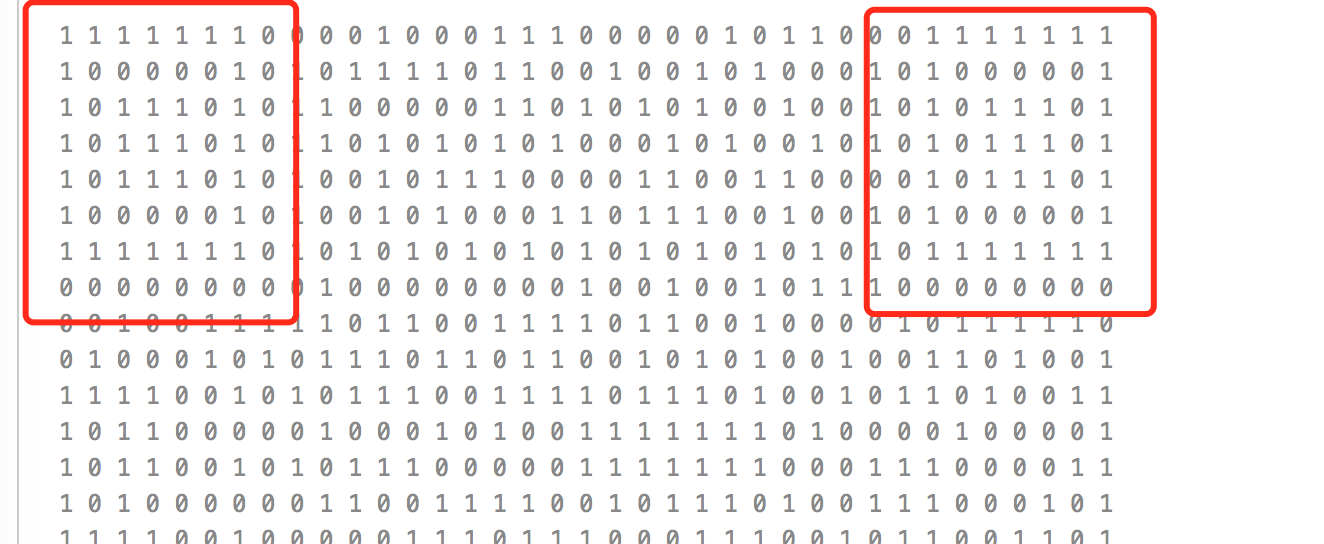 输入图片说明
输入图片说明
两者一结合,很容易就可以搞定探测图形的位置,第一行有多少个连续的1就表示探测图形的size是多大
所以探测图形的私人定制就比较简单了,下面是具体的绘制代码(下面实现图片绘制,内外框采用不同颜色的实现)
// 设置三个位置探测图形
if (x < detectCornerSize && y < detectCornerSize // 左上角
|| (x < detectCornerSize && y >= byteH - detectCornerSize) // 左下脚
|| (x >= byteW - detectCornerSize && y < detectCornerSize)) { // 右上角
if (qrCodeConfig.getDetectOptions().getDetectImg() != null) {
// 绘制图片
g2.drawImage(qrCodeConfig.getDetectOptions().getDetectImg(),
leftPadding + x * infoSize, topPadding + y * infoSize,
infoSize * detectCornerSize, infoSize * detectCornerSize, null);
for (int addX = 0; addX < detectCornerSize; addX++) {
for (int addY = 0; addY < detectCornerSize; addY++) {
bitMatrix.getByteMatrix().set(x + addX, y + addY, 0);
}
}
continue;
}
if (x == 0 || x == detectCornerSize - 1 || x == byteW - 1 || x == byteW - detectCornerSize
|| y == 0 || y == detectCornerSize - 1 || y == byteH - 1 || y == byteH - detectCornerSize) {
// 外层的框
g2.setColor(detectOutColor);
} else {
// 内层的框
g2.setColor(detectInnerColor);
}
g2.fillRect(leftPadding + x * infoSize, topPadding + y * infoSize, infoSize, infoSize);
}
到此,二维码主体的定制基本上over了,就最终的实现来看,我们的目标中除了logo和背景外,其他的基本上都是ok的,这里稍稍拓展了一点,如果连续两个为1,或一个小矩形全是1,则将这相同的几个串在一起,因此才有了上面的部分图形较大的情况(当然这个是可选的配置)
下面贴出整个绘制代码
public static BufferedImage drawQrInfo(QrCodeOptions qrCodeConfig, BitMatrixEx bitMatrix) {
int qrCodeWidth = bitMatrix.getWidth();
int qrCodeHeight = bitMatrix.getHeight();
int infoSize = bitMatrix.getMultiple();
BufferedImage qrCode = new BufferedImage(qrCodeWidth, qrCodeHeight, BufferedImage.TYPE_INT_RGB);
// 绘制的背景色
Color bgColor = qrCodeConfig.getDrawOptions().getBgColor();
// 绘制前置色
Color preColor = qrCodeConfig.getDrawOptions().getPreColor();
// 探测图形外圈的颜色
Color detectOutColor = qrCodeConfig.getDetectOptions().getOutColor();
// 探测图形内圈的颜色
Color detectInnerColor = qrCodeConfig.getDetectOptions().getInColor();
int leftPadding = bitMatrix.getLeftPadding();
int topPadding = bitMatrix.getTopPadding();
Graphics2D g2 = qrCode.createGraphics();
g2.setComposite(AlphaComposite.Src);
g2.setRenderingHint(RenderingHints.KEY_ANTIALIASING, RenderingHints.VALUE_ANTIALIAS_ON);
// 直接背景铺满整个图
g2.setColor(bgColor);
g2.fillRect(0, 0, qrCodeWidth, qrCodeHeight);
// 探测图形的大小
int detectCornerSize = bitMatrix.getByteMatrix().get(0, 5) == 1 ? 7 : 5;
int byteW = bitMatrix.getByteMatrix().getWidth();
int byteH = bitMatrix.getByteMatrix().getHeight();
boolean row2 = false;
boolean col2 = false;
QrCodeOptions.DrawStyle drawStyle = qrCodeConfig.getDrawOptions().getDrawStyle();
for (int x = 0; x < byteW; x++) {
for (int y = 0; y < byteH; y++) {
if (bitMatrix.getByteMatrix().get(x, y) == 0) {
continue;
}
// 设置三个位置探测图形
if (x < detectCornerSize && y < detectCornerSize // 左上角
|| (x < detectCornerSize && y >= byteH - detectCornerSize) // 左下脚
|| (x >= byteW - detectCornerSize && y < detectCornerSize)) { // 右上角
if (qrCodeConfig.getDetectOptions().getDetectImg() != null) {
g2.drawImage(qrCodeConfig.getDetectOptions().getDetectImg(),
leftPadding + x * infoSize, topPadding + y * infoSize,
infoSize * detectCornerSize, infoSize * detectCornerSize, null);
for (int addX = 0; addX < detectCornerSize; addX++) {
for (int addY = 0; addY < detectCornerSize; addY++) {
bitMatrix.getByteMatrix().set(x + addX, y + addY, 0);
}
}
continue;
}
if (x == 0 || x == detectCornerSize - 1 || x == byteW - 1 || x == byteW - detectCornerSize
|| y == 0 || y == detectCornerSize - 1 || y == byteH - 1 || y == byteH - detectCornerSize) {
// 外层的框
g2.setColor(detectOutColor);
} else {
// 内层的框
g2.setColor(detectInnerColor);
}
g2.fillRect(leftPadding + x * infoSize, topPadding + y * infoSize, infoSize, infoSize);
} else { // 着色二维码主题
g2.setColor(preColor);
if (!qrCodeConfig.getDrawOptions().isEnableScale()) {
drawStyle.draw(g2,
leftPadding + x * infoSize,
topPadding + y * infoSize,
infoSize,
infoSize,
qrCodeConfig.getDrawOptions().getImg());
continue;
}
// 支持拓展时
row2 = rightTrue(bitMatrix.getByteMatrix(), x, y);
col2 = belowTrue(bitMatrix.getByteMatrix(), x, y);
if (row2 && col2 && diagonalTrue(bitMatrix.getByteMatrix(), x, y) &&
qrCodeConfig.getDrawOptions().enableScale(QrCodeOptions.ExpandType.SIZE4)) {
// 四个相等
bitMatrix.getByteMatrix().set(x + 1, y, 0);
bitMatrix.getByteMatrix().set(x + 1, y + 1, 0);
bitMatrix.getByteMatrix().set(x, y + 1, 0);
drawStyle.draw(g2,
leftPadding + x * infoSize,
topPadding + y * infoSize,
infoSize << 1,
infoSize << 1,
qrCodeConfig.getDrawOptions().getSize4Img());
} else if (row2 && qrCodeConfig.getDrawOptions().enableScale(QrCodeOptions.ExpandType.ROW2)) { // 横向相同
bitMatrix.getByteMatrix().set(x + 1, y, 0);
drawStyle.draw(g2,
leftPadding + x * infoSize,
topPadding + y * infoSize,
infoSize << 1,
infoSize,
qrCodeConfig.getDrawOptions().getRow2Img());
} else if (col2 && qrCodeConfig.getDrawOptions().enableScale(QrCodeOptions.ExpandType.COL2)) { // 列的两个
bitMatrix.getByteMatrix().set(x, y + 1, 0);
drawStyle.draw(g2,
leftPadding + x * infoSize,
topPadding + y * infoSize,
infoSize,
infoSize << 1,
qrCodeConfig.getDrawOptions().getCol2img());
} else {
drawStyle.draw(g2,
leftPadding + x * infoSize,
topPadding + y * infoSize,
infoSize,
infoSize,
qrCodeConfig.getDrawOptions().getImg());
}
}
}
}
g2.dispose();
return qrCode;
}
private static boolean rightTrue(ByteMatrix byteMatrix, int x, int y) {
return x + 1 < byteMatrix.getWidth() && byteMatrix.get(x + 1, y) == 1;
}
private static boolean belowTrue(ByteMatrix byteMatrix, int x, int y) {
return y + 1 < byteMatrix.getHeight() && byteMatrix.get(x, y + 1) == 1;
}
// 对角是否相等
private static boolean diagonalTrue(ByteMatrix byteMatrix, int x, int y) {
return byteMatrix.get(x + 1, y + 1) == 1;
}
第三步. logo&背景的绘制
到第二步,其实二维码就已经绘制完成了,二维码和背景都是在二维码这种图片上做文章,一个是往二维码上加图片,一个是将二维码绘制在另一张图片上
一个图片在另一个图片上绘制没啥技术含量,稍微特别点的就是logo的圆角和边框了
《二维码服务拓展(支持logo,圆角logo,背景图,颜色配置)》 较清晰的说了如何绘制圆角图片,圆角边框
不想看上面博文的没啥关系,下面直接贴出代码,算是比较通用的方法了,与二维码项目本身没什么黏合
/**
* 生成边框
*
* @param image 原图
* @param cornerRadius 角度 0表示直角
* @param color 边框颜色
* @return
*/
public static BufferedImage makeRoundBorder(BufferedImage image,
int cornerRadius,
Color color) {
int size = image.getWidth() / 15;
int w = image.getWidth() + size;
int h = image.getHeight() + size;
BufferedImage output = new BufferedImage(w, h, BufferedImage.TYPE_INT_ARGB);
Graphics2D g2 = output.createGraphics();
g2.setComposite(AlphaComposite.Src);
g2.setRenderingHint(RenderingHints.KEY_ANTIALIASING, RenderingHints.VALUE_ANTIALIAS_ON);
g2.setColor(color == null ? Color.WHITE : color);
g2.fill(new RoundRectangle2D.Float(0, 0, w, h, cornerRadius, cornerRadius));
g2.setComposite(AlphaComposite.getInstance(AlphaComposite.SRC_ATOP, 1.0f));
g2.drawImage(image, size >> 1, size >> 1, null);
g2.dispose();
return output;
}
/**
* 生成圆角图片
*
* @param image 原始图片
* @param cornerRadius 圆角的弧度大小(根据实测效果,一般建议为图片宽度的1/4), 0表示直角
* @return 返回圆角图
*/
public static BufferedImage makeRoundedCorner(BufferedImage image,
int cornerRadius) {
int w = image.getWidth();
int h = image.getHeight();
BufferedImage output = new BufferedImage(w, h,
BufferedImage.TYPE_INT_ARGB);
Graphics2D g2 = output.createGraphics();
g2.setComposite(AlphaComposite.Src);
g2.setRenderingHint(RenderingHints.KEY_ANTIALIASING,
RenderingHints.VALUE_ANTIALIAS_ON);
g2.setColor(Color.WHITE);
g2.fill(new RoundRectangle2D.Float(0, 0, w, h, cornerRadius,
cornerRadius));
g2.setComposite(AlphaComposite.SrcAtop);
g2.drawImage(image, 0, 0, null);
g2.dispose();
return output;
}
与上一篇定制博文有一点区别的是,对背景图的支持进行了扩展,除了支持之前的设置二维码透明度,全覆盖背景图之外,又支持了在背景图的指定位置处进行绘制二维码,因为这一块确实没什么好讲的,干脆贴下代码好了
/**
* 绘制背景图
*
* @param source 二维码图
* @param bgImgOptions 背景图信息
* @return
*/
public static BufferedImage drawBackground(BufferedImage source, QrCodeOptions.BgImgOptions bgImgOptions) {
int sW = source.getWidth();
int sH = source.getHeight();
// 背景的图宽高不应该小于原图
int bgW = bgImgOptions.getBgW() < sW ? sW : bgImgOptions.getBgW();
int bgH = bgImgOptions.getBgH() < sH ? sH : bgImgOptions.getBgH();
// 背景图缩放
BufferedImage bg = bgImgOptions.getBgImg();
if (bg.getWidth() != bgW || bg.getHeight() != bgH) {
BufferedImage temp = new BufferedImage(bgW, bgH, BufferedImage.TYPE_INT_ARGB);
temp.getGraphics().drawImage(bg.getScaledInstance(bgW, bgH, Image.SCALE_SMOOTH)
, 0, 0, null);
bg = temp;
}
Graphics2D g2d = bg.createGraphics();
if (bgImgOptions.getBgImgStyle() == QrCodeOptions.BgImgStyle.FILL) {
// 选择一块区域进行填充
g2d.setComposite(AlphaComposite.getInstance(AlphaComposite.SRC_ATOP, 1.0f));
g2d.setRenderingHint(RenderingHints.KEY_ANTIALIASING, RenderingHints.VALUE_ANTIALIAS_ON);
g2d.drawImage(source, bgImgOptions.getStartX(), bgImgOptions.getStartY(), sW, sH, null);
} else {
// 覆盖方式
int x = (bgW - sW) >> 1;
int y = (bgH - sH) >> 1;
g2d.setComposite(AlphaComposite.getInstance(AlphaComposite.SRC_ATOP, bgImgOptions.getOpacity())); // 透明度, 避免看不到背景
g2d.setRenderingHint(RenderingHints.KEY_ANTIALIASING, RenderingHints.VALUE_ANTIALIAS_ON);
g2d.drawImage(source, x, y, sW, sH, null);
g2d.setComposite(AlphaComposite.getInstance(AlphaComposite.SRC_ATOP, 1.0f));
}
g2d.dispose();
bg.flush();
return bg;
}
测试
开发完了之后,就要开始愉快的进行测试了,测试一个全乎的
@Test
public void testGenStyleCodeV2() {
String msg = "http://weixin.qq.com/r/FS9waAPEg178rUcL93oH";
try {
String logo = "logo.jpg";
String bg = "qrbg.jpg";
BufferedImage img = QrCodeGenWrapper.of(msg)
.setW(550)
.setDrawPreColor(0xff002fa7) // 宝石蓝
.setDetectOutColor(0xff0000ff)
.setDetectInColor(Color.RED)
.setDetectImg("detect.png")
.setPadding(1)
.setErrorCorrection(ErrorCorrectionLevel.H)
.setLogo(logo)
.setLogoStyle(QrCodeOptions.LogoStyle.ROUND)
.setLogoBgColor(0xff00cc00)
.setLogoRate(15)
.setDrawStyle(QrCodeOptions.DrawStyle.IMAGE.name())
.setDrawEnableScale(true)
.setDrawImg("xhrBase.jpg")
.setDrawRow2Img("xhrr2.jpeg")
.setDrawCol2Img("xhrc2.jpeg")
.setDrawSize4Img("xhrSize4.jpg")
.setBgStyle(QrCodeOptions.BgImgStyle.FILL)
.setBgImg(bg)
.setBgStartX(230)
.setBgStartY(330)
.asBufferedImage();
ByteArrayOutputStream outputStream = new ByteArrayOutputStream();
ImageIO.write(img, "png", outputStream);
String img64 = Base64Util.encode(outputStream);
System.out.println("<img src=\"data:image/png;base64," + img64 + "\" />");
} catch (Exception e) {
System.out.println("create qrcode error! e: " + e);
Assert.assertTrue(false);
}
}
演示case:

一个最终定格的二维码
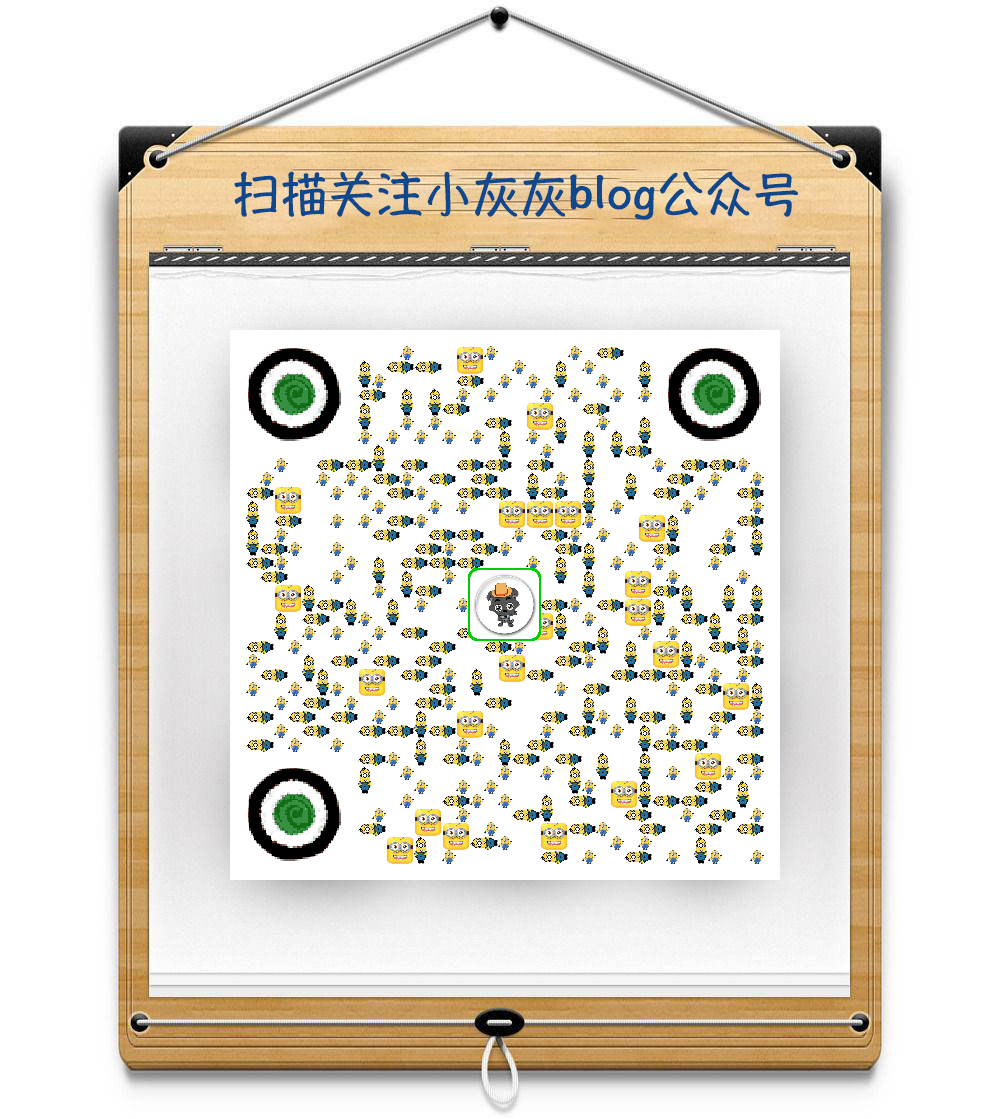 定格图
定格图
说明
上面的改造,在实际使用时,建议多测试测试是否可以扫描出来,腾讯系列产品的二维码扫描特别给力,一般都能很迅速的识别,其他的就不好说了
其他
相关博文
项目地址: https://github.com/liuyueyi/quick-media
个人博客:一灰的个人博客
公众号获取更多:
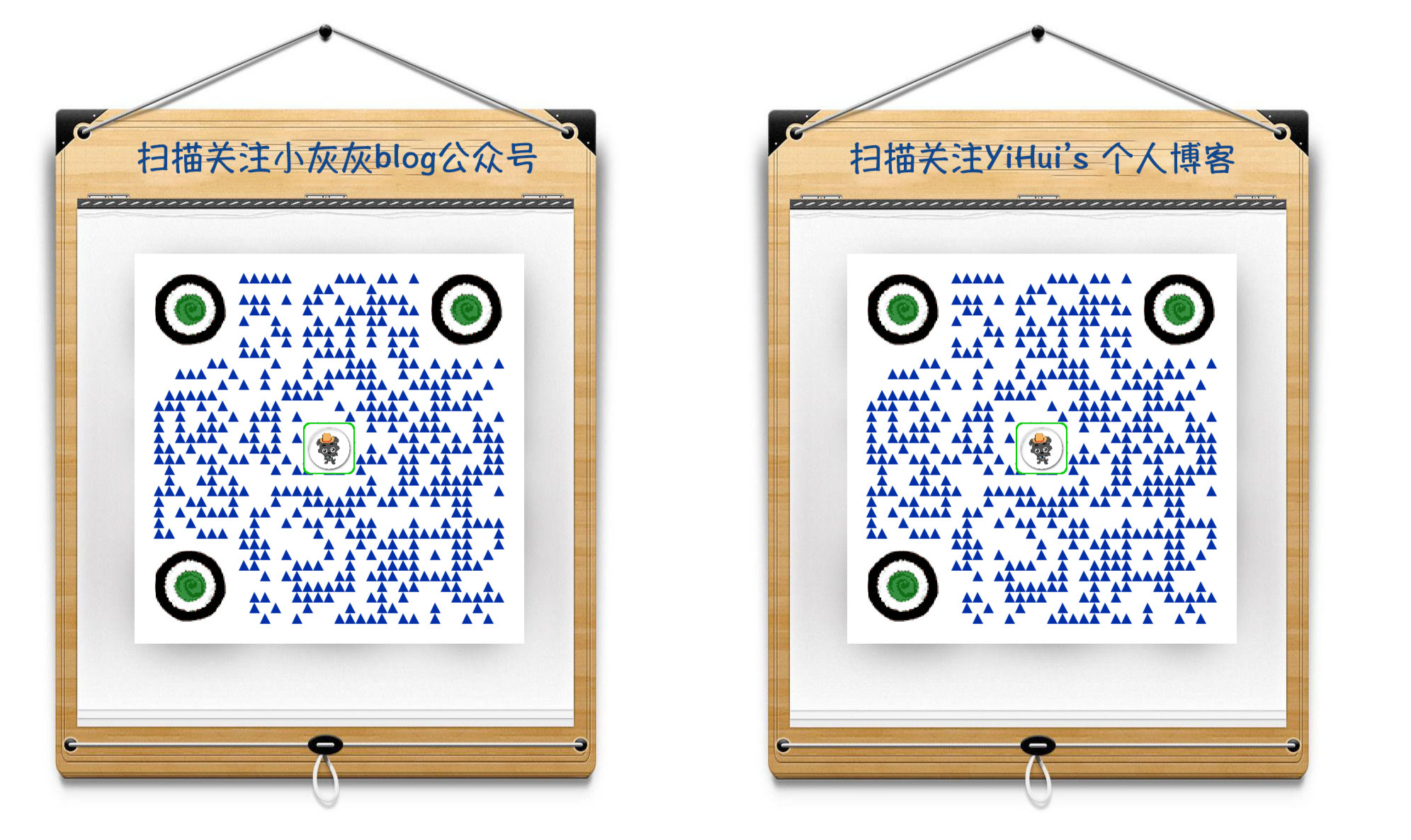 个人信息
个人信息


